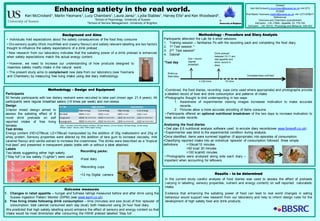
Scienfitic poster.pdf
- 1. Methodology – Design and Equipment Participants 50 female participants with low dietary restraint were recruited to take part (mean age: 21.4 years). All participants were regular breakfast eaters (>5 times per week) and non-obese. Design Test drinks Energy content (HE=279kcal, LE=78kcal) manipulated by the addition of 35g maltodextrin and 25g of whey protein. Sensory properties were altered by the addition of tara gum to increase viscosity, milk caramel flavour and vanilla extract to increase the creaminess. The drinks were described as a “tropical fruit lassi” and presented in transparent plastic bottle with or without a label attached. Labels Two labels suggesting either high satiety (“Stay full”) or low satiety (“Lighter”) were used. Methodology - Procedure and Diary Analysis Participants attended the Lab for 4 short sessions: 1. Training session – familiarise Ps with the recording pack and completing the food diary. 2. 1st Test session * 3. 2nd Test session* 4. Debrief *Test day •Combined, the food diaries, recording cups (only used where appropriate) and photographs provide a detailed record of food and drink consumption and patterns of intake. •Photographs thought to limit underreporting in two ways: 1. Awareness of experimenter viewing images increases motivation to make accurate records.. 2. Pictures allow a more accurate encoding of items consume • Participants offered an optional nutritional breakdown of the two days to increase motivation to keep accurate records. Recording packs: •Food diary •Recording cups •12 mp Digital camera „ Background and Aims • Individuals hold expectations about the satiety consequences of the food they consume • Oro-sensory quality (thick mouthfeel and creamy flavour) and satiety relevant-labelling are two factors thought to influence the satiety expectations of a drink preload . • New research from our laboratory indicates that the satiating power of a drink preload is enhanced when satiety expectations match the actual energy content. N = 50 High sensory Low sensory High energy Low energy High energy Low energy No label HSHE no label HSLE no label LSHE no label LSLE no label Congruent HSHE high satiety label HSLE low satiety label LSHE high satiety label LSLE low satiety label Incongruent HSHE low satiety label HSLEhigh satiety label LSHE low satiety label LSLE high satiety label 3-factor mixed design aimed to assess the satiating effect of 6 novel drink preloads on self reported intake of free living females Analysing the food diaries • Diet plan 6.6 nutritional analysis software used to encode diary records(see www.foresoft.co.uk). • Experimenter was blind to the experimental condition during analysis. Outcome measures 1. Changes in rated appetite – hunger and fullness ratings measured before and after drink using the Sussex Ingestion Pattern Monitor (SIPM) (see www.sipm.co.uk). 2. Free living intake following drink consumption – time (minutes) and size (kcal) of first „episode‟ of consumption; total calories consumed each day (kcal); both measured using 24 hour food diary. We predicted that high satiety labelling would enhance the effect of sensory and energy content so that intake would be most diminished after consuming the HSHE preload labelled „Stay full‟. Enhancing satiety in the real world. Keri McCrickerd1, Martin Yeomans1, Lucy Chambers1, Laura Jansz1, Lydia Stables1, Harvey Ells2 and Ken Woodward2, 1School of Psychology, University of Sussex 2School of Service Management, University of Brighton Contact Keri McCrickerd k.mccrickerd@sussex.ac.uk +441273 872826 Prof Martin Yeomans martin@sussex.ac.uk +44 1273 678617 References Yeomans and Chambers (unpublished) DeCastro , J.M. (1994). Appetite, 23, 179-192 DeCastro , J.M. (2010). Physiology and Behavior, 446-453 • Photographs were analysed along side each diary – important when accounting for leftovers. ≥ 120 mins 15 mins Eat + record regular breakfast . Drink preload between 10-11 am; rate appetite and drink, record in diary Wake up Start diary Complete diary until bed •Once identified, items were summed together (if appropriate) into episodes of consumption. •Classifying reported intake into an individual „episode‟ of consumption followed three simple definitions >10kcal/10 minutes >50 kcal/ 20 minutes >100 kcal/40 minutes • However, we need to increase our understanding of how products designed to maximise satiety modify intake in the natural world . • The present study aims to complement new data from our laboratory (see Yeomans and Chambers) by measuring free living intake using diet diary methodology. Table 1. Summary of the drink preload conditions. HS=high Sensory, LS=Low Sensory, HE=high energy, LE=low energy. Between subject : Sensory, label; Within subject: Energy. Results – to be determined In the current study careful analysis of food diaries was used to assess the effect of preloads (varying in labelling, sensory properties, nutrient and energy content) on self reported naturalistic intake. Evidence that enhancing the satiating power of food can lead to real world changes in eating behaviour would support new research from our laboratory and help to inform design rules for the development of high satiety food and drink products.